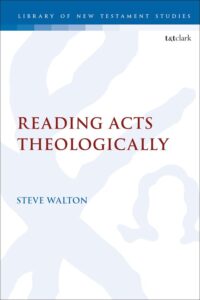A highlight of the British New Testament Conference this year was Dr Simon Gathercole’s scintillating and provocative plenary paper, ‘Jesus, the Apostolic Gospel and the Gospels’. Dr Gathercole is Senior Lecturer in New Testament in the Divinity Faculty, University of Cambridge, and in this paper he asked whether there is anything distinctive about the four canonical Gospels relative to the other Gospels we have. This is a hot question in New Testament Studies at present, for study of the non-canonical Gospels is a growth industry (to which Dr Gathercole himself has contributed mightily with two books on the Gospel of Thomas, here and here). Professor Francis Watson’s important and substantial study Gospel Writing, argues that there is very little distance between the canonical and non-canonical Gospels, and that they should be studied as one group of Gospels. The emphasis in scholarship has moved towards emphasising the diversity in early Christianity and, with Watson, doubts that there is a significant distinction between canonical and non-canonical Gospels (e.g., in addition to Francis Watson, see the work of Elaine Pagels, and Stephen Patterson—he in an important essay on ‘The Gospel of Thomas and Historical Jesus Research’). So how does Gathercole engage with this issue?
He focuses attention on the content of the Gospels, and argues that there are aspects of the four canonical Gospels which mark them out from most other non-canonical Gospels. The reason there is this distinction, he argues, is that the canonical Gospels are connected to an apostolic ‘creed’ or ‘rule of faith’ which corresponds to the early preached gospel message. Matthew, Mark, Luke and John emerge from a situation of developing norms of what constituted apostolic preaching—a ‘canon’ (in the sense of ‘rule’) which preceded the writing of the Gospels.
Gathercole identifies a group of seven extra-canonical Gospels with which he will engage: the Gospels of Peter, Truth, Thomas, Philip, Mary, the Egyptians, and Judas. This is the major group with which he compares the four canonical Gospels. His argument then proceeds in five steps.
First, he identifies the apostolic gospel message as a ‘rule of faith’ (regula fidei). He notes four key points:
- the identity of Jesus as ‘the Christ’
- Christ’s saving actions fulfil Scripture
- the atoning death of Jesus
- the resurrection of Jesus.
He finds these four points in ‘the gospel’ of 1 Corinthians 15:3-4, which it is widely agreed represents an early, traditional formulation of the gospel message. Verse 11 goes on to say that this message is preached by all, and Gathercole finds these four key points echoed in other NT (non-Gospel) authors, such as Hebrews 10, 1 Peter and Revelation. He thus claims that these four points form the very core of the apostolic gospel across a wide swath of earliest Christianity, and hence that they are not distinctively Pauline. They therefore form a good basis for assessing how far each of the eleven ‘Gospels’ reflect the apostolic gospel message.Steps 2 to 5 of his argument then consider these four points in turn, and compare the various Gospels with them.
On ‘Christ’, that is that Jesus is anointed by the creator God of Israel, the canonical Gospels are explicit. Mark 1:1; 8:19 identify Jesus thus. Matthew presents Jesus as son of David, and son of Abraham, and includes Jesus’ dialogue with John the baptist about Jesus’ identity, as well as repeating much from Mark. John 1 has Jesus recognised as king of Israel, and John 3 has him as Messiah, and stating that salvation comes from the Jews.
By contrast, the extra-canonical Gospel avoid ‘Christ’ as a title for Jesus, and prefer saviour, son of man, son of God, king of Israel, and Lord. GTruth has ‘Christ’ only twice, GPhilip a little, but both are clearly concerned with Jesus from a Valentinian perspective, and thus the connection with the creator is thin. GJudas rejects the title ‘Christ’; it is given new content in GThomas, GPhilip and GTruth, and GEgyptians separates Jesus from the Christ. Of the extra-canonical Gospels, only GPeter seems to have this theme.
On the fulfilment of Scripture, the canonical Gospels make seeing Jesus’ life and work through the lens of Scripture central. Mark sees the passion and resurrection of Jesus as ‘necessary’ in the light of Scripture; Jesus is understood to have the authority of the Danielic son of man, and he is welcomed to Jerusalem as fulfilling Psalm 118; in the passion narrative, Zechariah and Psalm 22 are significant texts seen as fulfilled by Mark. Much of this material is shared with Matthew and Luke. Matthew adds Jesus as a new Jonah, and Luke fills his infancy and resurrection narratives with scriptural allusions, again using ‘it is necessary’ language pointing to scriptural fulfilment. John uses scriptural analogies for the work of Jesus, and points to incidents in the passion which fulfil Scripture; his resurrection story draws attention to Peter and John not realising from Scripture that Jesus must rise from the dead.
By contrast, two main approaches are found in the extra-canonical Gospels. Some regard Scripture as irrelevant (GTruth, GPhilip), and others regard Scripture as unhelpful (GThomas, GEgyptians). Again, GPeter stands out as making the connection with Scripture positively.
On Jesus’ atoning death, all agree that Jesus died; as Pagels notes, the key question is about its significance, and Pagels asserts that there is disagreement among the early sources on this. Matthew and Mark both report the important ‘ransom’ saying, and the synoptic Gospels each record the eucharistic teaching of Jesus, which interprets his death as atoning. The synoptics also tell the story of the exchange of the guilty Barabbas and the innocent Jesus, the tearing of the temple curtain, and describe Jesus as one who saves people from their sins (cf. Acts 20:28 too). John speaks of Jesus as the lamb of God, claims that Jesus’ flesh and blood bring eternal life, has Jesus saying that he lays down his life for the flock. Caiaphas speaks of one dying for the people. Jesus is the seed which falls into the ground and dies, and thus bears much fruit, and so on.
Some extra-canonical Gospels, by contrast, contain no reflection on the cross (GMary, GJudas). Others see Jesus’ death as for many (GTruth), see the cross as Jesus’s place of departure (GPhilip), have a walking cross, but no preaching of the cross (GPeter), or use taking up the cross only as a model (GThomas). There is, in other words, one of three views: Jesus’ death is rejected, of limited significance, or an effective atoning death—and the latter is found only in the four canonical Gospels and GTruth.
On resurrection on the third day, the four canonical Gospels each in their own way report and record this. In Mark, the treatment is limited, but the three passion predictions clearly point towards it (8:31; 9:31; 10:33). Matthew and Luke repeat Mark’s point about the necessity of Jesus’ resurrection, and narrate stories of his appearances. John announces the resurrection in advance and then narrates stories. Luke and John, in particular, insist on the physicality of the resurrection. All four have Jesus raised on the third day.
The extra-canonical Gospels may lack resurrection (GEgyptians, GJudas), or be uncertain (GMary; GThomas speaks of Jesus as living, which implies resurrection, but is negative about the idea of a general resurrection), or use resurrection imagery without speaking of Jesus’ resurrection (GPhilip, GTruth). Only GPeter has Jesus emerge from the tomb—in fact, GPeter goes further than the four canonical Gospels by telling the story of the moment of Jesus’ emerging from the tomb, preceded by the walking, talking cross.
In sum, it is not that the canonical Gospels are the only ones which have any of these four ‘rule of faith’ elements—but it is the case that the four canonical Gospels are the only ones which each contain all of the four ‘rule of faith’ elements typified in 1 Corinthians 15:3-4. Gathercole notes that his argument depends neither on the relative dates of these documents (so some extra-canonical Gospels could be earlier than canonical Gospels), nor on their attestation. It is clear that the canonical Gospels are much closer to each other than any of the extra-canonical Gospels, and this is reached not by producing an arbitrary set of criteria, but by comparing the Gospels with the widely-used four elements of the apostolic gospel message.
This is a brilliantly simple argument, in my view, and reminds me in some respects of C. H. Dodd’s argument in his The Apostolic Preaching and its Developments. There Dodd looks at the evangelistic speeches in Acts, identifies a pattern of regularly recurring points, and then shows that these elements are reflected in the shape of Mark’s Gospel—and goes on to suggest that this may be reason that the Gospels were given a name which traditionally applied to a message: gospel.


